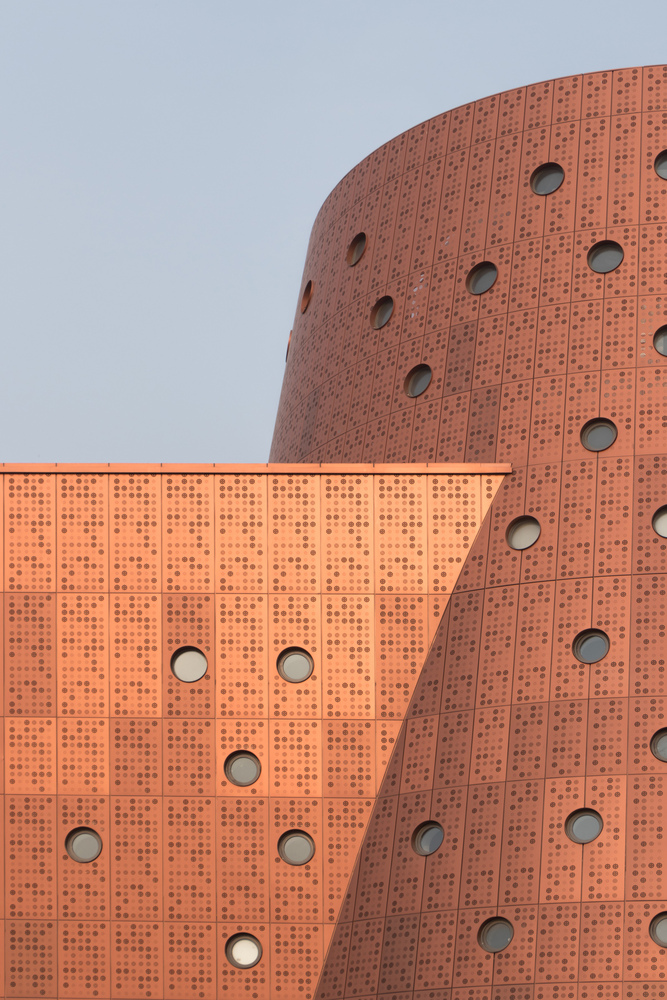Warehouse of Time FT Architects
2017-08-15 20:00
架构师提供的文本描述。建筑作为考古学
Text description provided by the architects. Architecture as Archaeology
这座建筑是1896年建造的一座砖砌仓库的翻新工程。它是由清水-十(目前是日本最大的建筑公司之一)设计和建造的,储存茧是高端产品,使用当时的最新技术。从优质砖块的铺设、9m×36m的无柱大空间、特大柱桁架和通风控制湿度的窗配件中可以看出。这是日本历史上第一次在西方国家建造的砖房达到了同样的质量。最终,它成为一座被列为有价值的工业遗产的国家建筑,并计划将其改造为洪乔市的一个社区中心。
This architecture is a renovation of a brick warehouse built in 1896. It was designed and built 120 years ago by Shimizu-ten (currently one of the biggest construction companies in Japan) to storage cocoons, which were high-end products and uses the latest technology at that time. It could be seen in the high-quality bricks and laying of it, the large column-free space of 9m by 36m achieved by a king post truss and the window fittings that could ventilate and control humidity. This was the first time in Japanese history that a brick building achieved the same quality built in the western countries. Eventually it became a national listed building as a valuable industrial heritage and a preservation and renovation project was planned to transform it to a community center for the city of Honjo.
© Shigeo Ogawa
(小川茂雄)


早稻田大学的一个小组对历史、结构、物质、城市化和灾害管理等各个领域进行了初步研究,有几件事变得清晰起来。现有建筑的砖墙和木桁架至今仍作为结构构件,但短边屈服强度不足。另一件事是,完工时没有详细的图纸,而且由于是私有的,因此进行了几次翻修。从研究中获得的信息是由于该仓库已有120年历史而造成的碎片。然而,它成为确定改造方向的一条有价值的线索。通过本研究小组和美国建筑师的合作,确定了该项目的两个主题。一种是抗震加固,尽量不干扰砖混结构和木桁架的现有空间;二是空间设计,我们务实地处理转换的痕迹,作为过去事件的代表。
A preliminary research was conducted by a team of Waseda University across various fields, such as history, structure, material, urbanism and disaster management and several things became clear. The existing architecture’s brick wall and timber truss were still acting as structural elements even today, but the yield strength on the short side was insufficient. Another thing was that, there were no detailed drawings when it was completed existing and several renovations were conducted since it was privately owned. The information gained from the research were fragments due to the warehouse being 120 years old. However, it became a valuable clue to determine the direction of the renovation. Through the collaboration of this research team and us architects, 2 themes for this project were determined. One is the seismic reinforcement not interfering with the existing space of brick masonry and timber truss as much as possible and another is the spatial design where we deal with the traces of the conversions pragmatically, as representation of the past events.
Courtesy of FT Architects
英国“金融时报”建筑师的礼遇




© Shigeo Ogawa
(小川茂雄)


采用钢结构进行抗震加固,以便与现有建筑区别开来,使其具有与现代建筑相同的抗震性能。短边的屈服强度不足,采用高层楼板和屋顶等水平单元加固,建成后完全看不见。立柱等垂直单元通过相互依赖于现有的砖墙而成为最小尺寸,并与砖空间形成对比。废料和建筑是日本建筑的主导文化,即使我们能够保护老建筑,现有的建筑通常只是作为一个外观。我们在日本的创新之处在于,我们能够从结构上评估和利用现有的架构。
The seismic reinforcement was done by steel structure, in order to clearly distinguish with the existing architecture and we aimed to have the same seismic performance as a contemporary architecture. The insufficient yield strength of the short side was reinforced with the horizontal elements such as the floor of the upper storey and roof, where it becomes completely unseen when completed. The vertical elements such as columns becomes the minimum size by mutually depending on the existing brick wall and appears as a contrast to the brick space. Scrap and build is the dominant culture in Japanese architecture and even if we were able to preserve old buildings, the existing structure is usually only used as a façade. It was innovative for us in Japan that we were able to structurally evaluate and utilize the existing architecture.
© Shigeo Ogawa
(小川茂雄)


Courtesy of FT Architects
英国“金融时报”建筑师的礼遇


© Shigeo Ogawa
(小川茂雄)


现有建筑是在新西方构造与日本传统构造的折衷时期建立起来的,造成了日西方秩序(维度体系)的混合使用。例如,梁是在日本传统的“沙库”舱中建造的,而柱子则是在西舱“英寸”中建造的,而其他元素则是在不同的模块中建造的,因此在它们之间出现了一个缺口。在这些不同等级的间隙中仔细地插入了抗震加固,这样以后就有可能将它们分离出来。
The existing architecture was built in the eclectic period of the new Western tectonics and the traditional Japanese tectonics, resulting in the mixed use of Japanese and Western order (dimension system). For instance, the beams are built in the Japanese traditional module “Shaku” whereas the columns are built in the Western module “inch”, and other elements are built in different modules, thus a gap occurs between them. The seismic reinforcement is carefully inserted in these gaps of different orders, so it is possible to detach them in the future.
© Shigeo Ogawa
(小川茂雄)


这些转换的痕迹是函数变化与空间之间的差距的结果。我们认为它们不是缺陷,而是过去累积事件的代表。这并不意味着要留下过去的翻新。我们删除了不必要的部分,修复了破损的部分,但没有试图模仿或恢复原来的。这种巧妙的操作是改造空间设计中最重要的一点。有时它可能会变得奇怪,但我们记住他们更务实的坚定。
The traces of the conversions are the results of the gap between the change of the function and the space. We thought of them not as defects but as the representation of the accumulated events of the past. This doesn’t mean to leave the past renovations as it is. We removed the unnecessary and repaired the broken parts, but didn’t try to imitate or restore them to the original. This skillful handling was the most important point in the spatial design of the renovation. Sometimes it might become grotesque but we kept in mind more of the pragmatic firmness of them.
© Shigeo Ogawa
(小川茂雄)


如果人们能把这个建筑看作是保存和翻新项目的原型,我们会很高兴,因为这里的文件很少,建筑预算也很少。这并不是要逆转时间的流动,而是通过将填补空白所留下的历史碎片与想象联系起来重建历史。这是一种考古学的建筑思维方式,这里站在建筑师参与旧建筑改造工程的意义所在。当您实际访问仓库时,架构师似乎什么也没做。然而,对于这种架构来说,这是最幸运的事情。
We would be glad if people could think of this architecture as a prototype for preservation and renovation projects where there is few documents and little construction budget. It is not about reversing the flow of time, but reconstructing its history by connecting the historical fragments left through filling the gaps with imagination and connect them to the future. This is an archaeological way of thinking in architecture and here stands the meaning of architects to participate in renovation projects of old architecture. When you actually visit the warehouse, it would seem that the architect didn’t do anything. However, that is the most fortunate thing for this architecture.
© Shigeo Ogawa
(小川茂雄)














































Architects FT Architects
Location Saitama, Saitama Prefecture, Japan
Architects in Charge Katsuya Fukushima, Hiroko Tominaga
Area 711.0 m2
Project Year 2017
Photographs Shigeo Ogawa
Category Restoration
Manufacturers Loading...
























